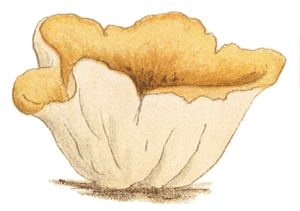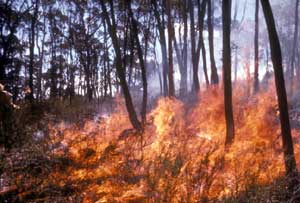 Fungal
ecology
Fungal
ecology
Fungi and fire
Some fungi are found only in burnt areas, or at least have strong preferences
for burnt areas, and there are others which can do well in unburnt areas but
get a boost from fires. For example, while Morchella elata ![]() will produce fruiting bodies in the absence of fire, abundant fruiting body
production can be triggered by fire. About a year after a severe bushfire in
Namadgi National Park south of Canberra, this fungus produced hundreds of fruiting
bodies in one particular locality.
will produce fruiting bodies in the absence of fire, abundant fruiting body
production can be triggered by fire. About a year after a severe bushfire in
Namadgi National Park south of Canberra, this fungus produced hundreds of fruiting
bodies in one particular locality.
 If
you’re searching for information about such fungi you can find a variety
of adjectives used to describe them, some derived from various Latin or Classical
Greek roots - anthracophilous (literally "coal-loving"), pyrophilous
("fire-loving"), carbonicolous ("coal-inhabiting"). They
are also called phoenicoid or fireplace fungi. The word phoenicoid is derived
from Phoenix, the mythical bird which was said to live for 500 years and then
set fire to its nest and die there - whereupon the new Phoenix would arise from
the ashes of the old one. At any given time there was only one Phoenix alive.
If
you’re searching for information about such fungi you can find a variety
of adjectives used to describe them, some derived from various Latin or Classical
Greek roots - anthracophilous (literally "coal-loving"), pyrophilous
("fire-loving"), carbonicolous ("coal-inhabiting"). They
are also called phoenicoid or fireplace fungi. The word phoenicoid is derived
from Phoenix, the mythical bird which was said to live for 500 years and then
set fire to its nest and die there - whereupon the new Phoenix would arise from
the ashes of the old one. At any given time there was only one Phoenix alive.
Another place to find some of the phoenicoid fungi is on soil that has been steam sterilized.
One effect of fire (or heat in general) is that it stimulates the germination
of the spores of a number of fungi, including species in the genus Anthracobia
![]() .
Interestingly, the heat of a fire may also induce the germination of the spores
of various dung fungi that are lying dormant in the soil. The spores of many
of the species involved would often be deposited on grass and other vegetation
that is eaten by herbivores, after which the heat and digestive juices within
the animals would make the spores ready for germination once they’re ejected
with the faeces.
.
Interestingly, the heat of a fire may also induce the germination of the spores
of various dung fungi that are lying dormant in the soil. The spores of many
of the species involved would often be deposited on grass and other vegetation
that is eaten by herbivores, after which the heat and digestive juices within
the animals would make the spores ready for germination once they’re ejected
with the faeces.
As well as stimulating spore germination, fires will also stimulate the sclerotia
of some species to produce fruiting bodies. An Australian example of this is
Laccocephalum mylittae, previously called Polyporus mylittae ![]()
![]() .
One of the photos shows a roughly spherical sclerotium, cut open to reveal the
internal structure, and the other shows a couple of fruiting bodies. Note that
while fire will trigger fruiting body production, it is not essential. These
fruiting bodies were produced by keeping a slice of a sclerotium moist and in
a warm room for a few weeks.
.
One of the photos shows a roughly spherical sclerotium, cut open to reveal the
internal structure, and the other shows a couple of fruiting bodies. Note that
while fire will trigger fruiting body production, it is not essential. These
fruiting bodies were produced by keeping a slice of a sclerotium moist and in
a warm room for a few weeks.
Heating also kills many of the soil micro-organisms that would often compete
with, or be antagonistic to, fungi. The phoenicoid fungi undoubtedly take advantage
of this reduced competition to colonize burnt areas. The genus Pyronema
![]() occurs in burnt areas worldwide and the fruiting bodies of this genus appear
fairly early after fires. Studies on overseas Pyronema species have shown
that the mycelia of these species grow very rapidly and are able to colonize
large areas quickly. The species pictured here was photographed on Black Mountain
in Canberra, just a few weeks after a severe bushfire. The individual fruiting
bodies are only about a millimetre in diameter but appeared in such profusion
that they blended to create pinkish-orange carpets across the burnt soil. You
can see a few individual fruiting bodies in the photo, sitting apart from the
massed ones. At the time this photograph was taken, the carpets of Pyronema
covered extensive areas of Black Mountain Reserve.
occurs in burnt areas worldwide and the fruiting bodies of this genus appear
fairly early after fires. Studies on overseas Pyronema species have shown
that the mycelia of these species grow very rapidly and are able to colonize
large areas quickly. The species pictured here was photographed on Black Mountain
in Canberra, just a few weeks after a severe bushfire. The individual fruiting
bodies are only about a millimetre in diameter but appeared in such profusion
that they blended to create pinkish-orange carpets across the burnt soil. You
can see a few individual fruiting bodies in the photo, sitting apart from the
massed ones. At the time this photograph was taken, the carpets of Pyronema
covered extensive areas of Black Mountain Reserve.
One experiment with Pyronema domesticum, a species not known to occur
in Australia, showed that this fungus would produce fruiting bodies readily
if spores were added to a sample of sterilized soil at the same time or before
some non-sterile soil was also added to the sterilized soil. However, if non-sterile
soil was added to the sterilized soil three days before the addition of the
Pyronema spores, no fruiting bodies were produced. In the first case
Pyronema either gets a head start, or the rapidly growing mycelium can
grow quickly ahead of any invading competitors from the unsterilized soil. ![]() Either
way, the Pyronema mycelium grows well enough to be able to produce fruiting
bodies.In the latter instance, where there’s established competition, Pyronema
does poorly.
Either
way, the Pyronema mycelium grows well enough to be able to produce fruiting
bodies.In the latter instance, where there’s established competition, Pyronema
does poorly.
Fires also change soil chemistry, the ash temporarily increasing the alkalinity and various studies have shown that some of the phoenicoid fungi are responding primarily to the increased alkalinity, rather than to the fire itself. Such fungi can also be found in alkaline habitats, for example areas where building mortar or plaster has been dumped. Pyronema domesticum is an example of a fungus that can be found on plaster.
While a fire brings about a dramatic change in aspects such as soil chemistry, nutrient supply and microbial mix, the new state will not remain unaltered. Various plants, animals and fungi will re-colonize the area and survivors will pick up their lives and adjust as best as possible to the new conditions. In the years after a fire features such as soil chemistry, nutrient supply and microbial mix will change, creating a sequence of habitat changes which will influence the fungal population in the area. So, the fungi that appear soon after fire may be displaced by other species as conditions change.
An excellent review of research into fungi and fire in Australia appeared in 2011 (S.J.M. McMullan-Fisher, T.W. May, R.M. Robinson, T.L. Bell, T. Lebel, P. Catcheside & A. York. Australian Journal of Botany, 59, 70-90). As well as summarizing research on various topics the paper lists over 200 references dealing with fungi and fire in Australia or overseas.
![An Australian Government Initiative [logo]](/images/austgovt_brown_90px.gif)

